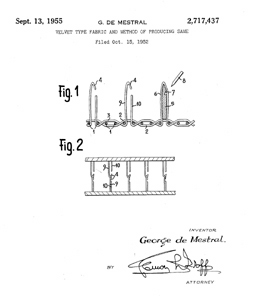 The idea for Velcro came to George de Mestral, a Swiss engineer, after returning from a walk in the Alps with his dogs. He examined the burrs stuck to both his jacket and the dogs’ fur under a microscope. The principal, he discovered, was simple. The burr was made of hundreds of hooks that would catch on anything with a loop such as cloth, animal fur or hair. De Mestral saw that this design could be used as a new type of fastener if he could duplicate the hooks and loops.
The idea for Velcro came to George de Mestral, a Swiss engineer, after returning from a walk in the Alps with his dogs. He examined the burrs stuck to both his jacket and the dogs’ fur under a microscope. The principal, he discovered, was simple. The burr was made of hundreds of hooks that would catch on anything with a loop such as cloth, animal fur or hair. De Mestral saw that this design could be used as a new type of fastener if he could duplicate the hooks and loops.
Needing the services of a professional weaver, he took his idea to Lyon, France, a center of weaving at the time. Here, no one was willing to take him seriously at first. He finally found one weaver willing to help him. This weaver made two cotton strips that did work but the cotton wore out very quickly. So de Mestral turned to synthetic fabrics. Nylon was a very new invention at the time and he decided to give it a try because it did not rot, break down or attract mold. After much experimentation, he discovered that when sewn under hot infrared light, nylon formed hooks that were perfect for the hook side of the fastener. Making the looped side was another problem entirely. Nylon thread was resilient and when heated would retain its shape but it had to be cut in just the right spot so that it could be stuck and unstuck repeatedly. Eventually, when he was about to give up, he cut the tops off of the loops and created hooks that match up perfectly with the loops. After finally perfecting his idea, de Mestral spent the next eight years developing a mechanizing process.
 De Mestral immediately applied for patents for his invention in many countries. The US patent application for Velcro was filed on October 15, 1952. Patent 2,717,437 was granted to De Mestral on September 13, 1955 for velvet type fabric and method for producing same.
De Mestral immediately applied for patents for his invention in many countries. The US patent application for Velcro was filed on October 15, 1952. Patent 2,717,437 was granted to De Mestral on September 13, 1955 for velvet type fabric and method for producing same.
He thought his new fastener would quickly be widely used but he was wrong. The clothing industry did not immediately start using Velcro mainly because of its unattractive appearance. Velcro had its first commercial success when NASA discovered that it was much less cumbersome than zippers and buttons on the astronaut’s space suits. The makers of ski apparel and scuba gear soon followed suit and begin using Velcro as well. Velcro became a very successful product used as a fastener in many industries around the world.
De Mestral’s once offered a piece of advice to Velcro executives. He said, “If any of your employees ask for a two-week holiday to go hunting, say yes”.
